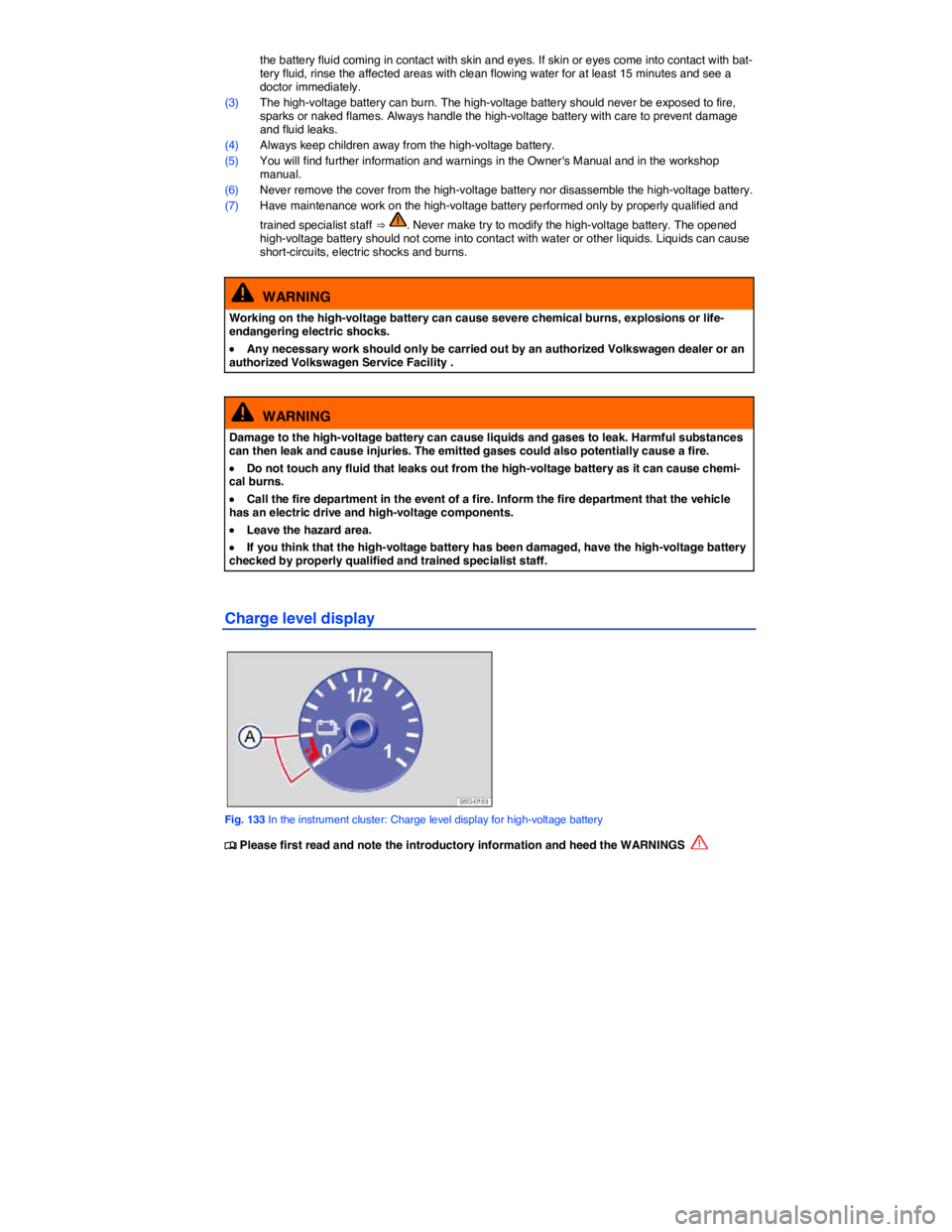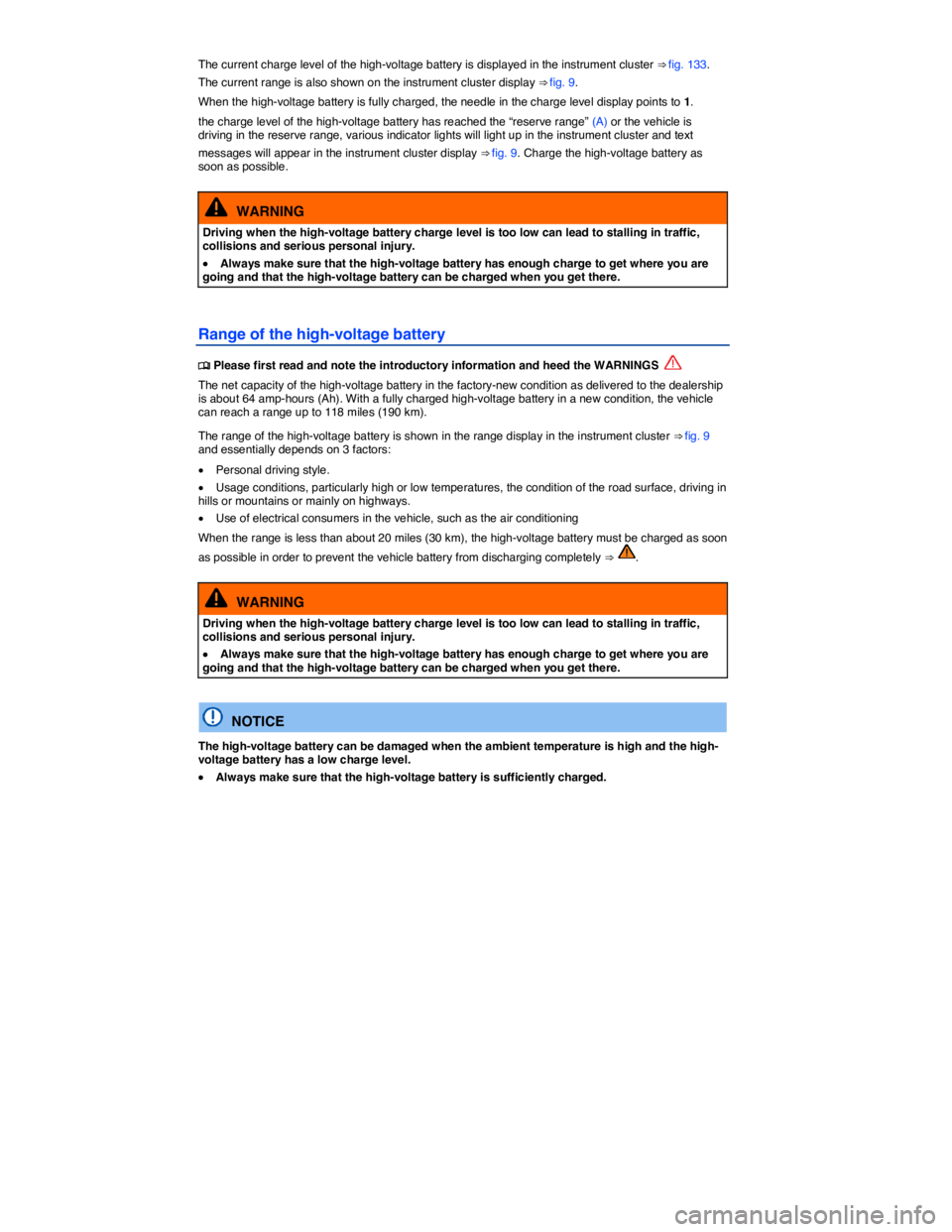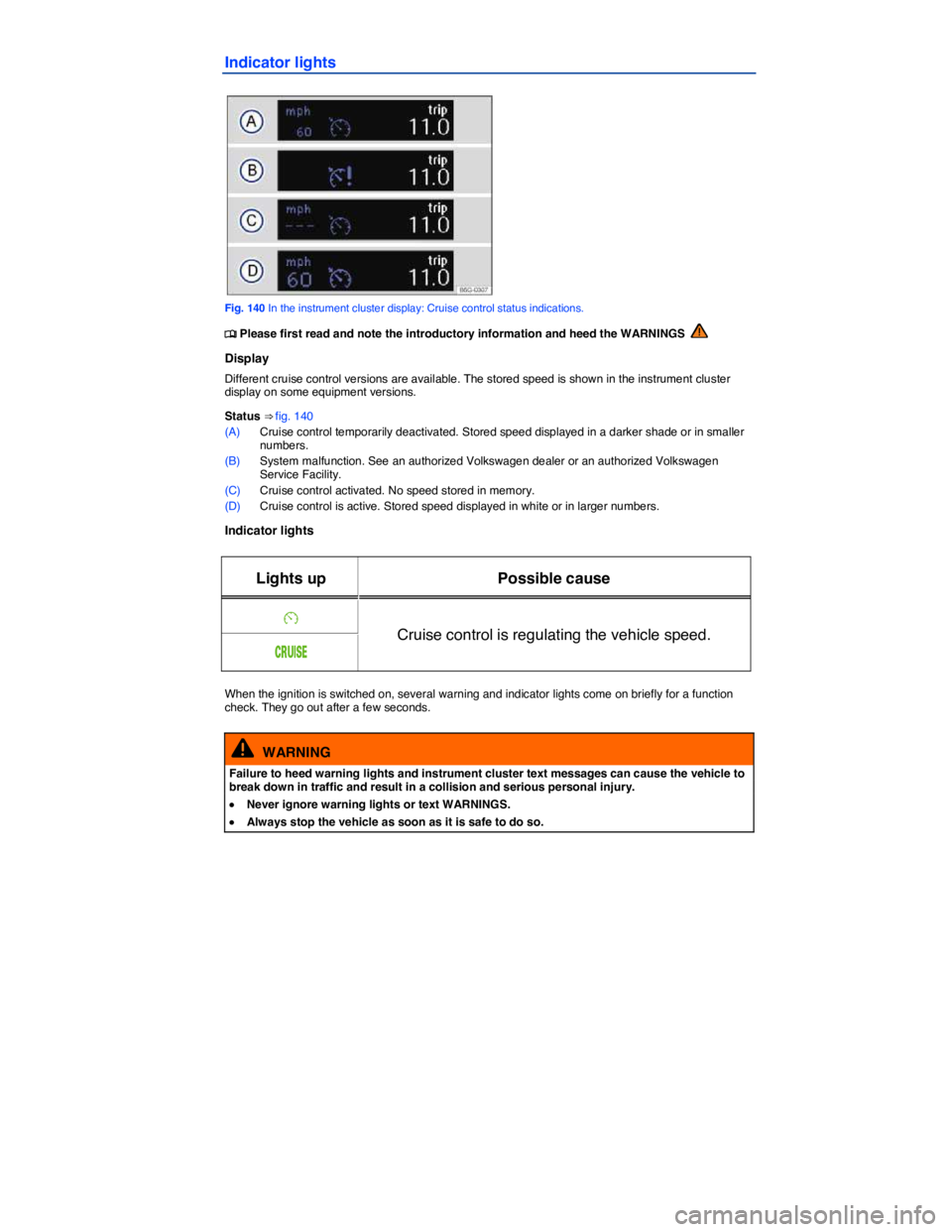2019 VOLKSWAGEN E-GOLF instrument
[x] Cancel search: instrumentPage 239 of 394

mance by applying more pressure to the brake pedal. But, during the break-in period, the stopping distance for hard braking and emergency braking will be longer until the brakes are fully broken in. Avoid hard braking and situations that might require hard braking (such as following other vehicles too closely) – especially during the break-in period.
Brake pad wear depends mostly on operating conditions and the way the vehicle is driven. If you do a lot of city and short-distance driving and/or have a sporty driving style, you should have the brake pads checked by an authorized Volkswagen dealer or authorized Volkswagen Service Facility more often than the regular service intervals.
Wet brakes (for example, after driving through water or washing the vehicle or after heavy rainfall) will not brake as well. Stopping distances will be longer when brake discs are wet or, in winter, even icy. Wet or icy brakes must be dried as soon as possible by carefully applying the brakes a couple of times while traveling at a relatively high speed. Make sure nobody is behind you and that you do not endan-
ger yourself or others ⇒ .
Brakes coated with road salt also react slower and need longer stopping distances. If there is salt on the roads and you are not braking regularly, brake carefully and gently from time to time to remove any
salt coating from the brake discs and pads ⇒ .
Brake disc corrosion (rust) and dirt buildup on the brake pads are more likely to occur if the vehicle is not driven much or is driven only for short distances with little braking. If the brakes have not been used and there is some rust on the discs, clean the brake discs and pads once in a while by carefully braking a couple of times while driving at relatively high speed to help clean the brake discs and pads.
Make sure nobody is behind you and that you do not endanger yourself or others ⇒ .
Brake system malfunction
If you brake and find that the vehicle doesn't brake nearly as well as it used to (sudden increase in stopping distance), a brake circuit may have failed. The brake warning light �H or �"�2�!�+�% will light up and a message may appear in the instrument cluster display. If you believe the vehicle is safe to drive, immediately take it to the nearest authorized Volkswagen dealer or authorized Volkswagen Service Facility for repair. Drive slowly and very carefully, allow for the longer stopping distance, and be ready to push longer and harder on the brake pedal to slow the vehicle down.
Electro-mechanical brake booster
The electro-mechanical brake booster works only when the electric motor is activated. It increases the force on the brakes above and beyond the pressure put on the brake pedal by the driver.
If the electro-mechanical brake booster is not working, you will have to push the brake pedal harder to
make up for the lack of booster assistance and the resulting longer stopping distance ⇒ .
WARNING
New brake pads do not provide maximum braking performance.
�x New brake pads do not have the best stopping power for the first 185 miles (300 km) and must be “broken in.” You can compensate for the slightly reduced braking force by putting more pressure on the brake pedal.
�x Drive with extra care while the new brake pads are being broken in. This reduces the risk of collisions and serious personal injuries due to a loss of control over the vehicle.
�x Never follow other vehicles too closely or put yourself into other situations that might require sudden, hard braking, especially when the brake pads have not been broken in.
Page 251 of 394

the battery fluid coming in contact with skin and eyes. If skin or eyes come into contact with bat-tery fluid, rinse the affected areas with clean flowing water for at least 15 minutes and see a doctor immediately.
(3) The high-voltage battery can burn. The high-voltage battery should never be exposed to fire, sparks or naked flames. Always handle the high-voltage battery with care to prevent damage and fluid leaks.
(4) Always keep children away from the high-voltage battery.
(5) You will find further information and warnings in the Owner's Manual and in the workshop manual.
(6) Never remove the cover from the high-voltage battery nor disassemble the high-voltage battery.
(7) Have maintenance work on the high-voltage battery performed only by properly qualified and
trained specialist staff ⇒ . Never make try to modify the high-voltage battery. The opened high-voltage battery should not come into contact with water or other liquids. Liquids can cause short-circuits, electric shocks and burns.
WARNING
Working on the high-voltage battery can cause severe chemical burns, explosions or life-endangering electric shocks.
�x Any necessary work should only be carried out by an authorized Volkswagen dealer or an authorized Volkswagen Service Facility .
WARNING
Damage to the high-voltage battery can cause liquids and gases to leak. Harmful substances can then leak and cause injuries. The emitted gases could also potentially cause a fire.
�x Do not touch any fluid that leaks out from the high-voltage battery as it can cause chemi-cal burns.
�x Call the fire department in the event of a fire. Inform the fire department that the vehicle has an electric drive and high-voltage components.
�x Leave the hazard area.
�x If you think that the high-voltage battery has been damaged, have the high-voltage battery checked by properly qualified and trained specialist staff.
Charge level display
Fig. 133 In the instrument cluster: Charge level display for high-voltage battery
�
Page 252 of 394

The current charge level of the high-voltage battery is displayed in the instrument cluster ⇒ fig. 133.
The current range is also shown on the instrument cluster display ⇒ fig. 9.
When the high-voltage battery is fully charged, the needle in the charge level display points to 1.
the charge level of the high-voltage battery has reached the “reserve range” (A) or the vehicle is driving in the reserve range, various indicator lights will light up in the instrument cluster and text
messages will appear in the instrument cluster display ⇒ fig. 9. Charge the high-voltage battery as soon as possible.
WARNING
Driving when the high-voltage battery charge level is too low can lead to stalling in traffic, collisions and serious personal injury.
�x Always make sure that the high-voltage battery has enough charge to get where you are going and that the high-voltage battery can be charged when you get there.
Range of the high-voltage battery
�
Page 273 of 394

Indicator lights
Fig. 140 In the instrument cluster display: Cruise control status indications.
�
Page 300 of 394

�x Turn the temperature knob to the center position.
�x Open and adjust all air vents in the instrument panel ⇒, Air vents.
�x Turn the air distribution knob to the desired setting.
�x Push the �!�
Page 301 of 394

Air vents
Fig. 151 In the instrument panel: Air vents.
�
Page 317 of 394

should always be replaced by a qualified technician, since the vehicle's onboard electrical system management has to be reset after replacing the battery. Only a qualified service facility is able to perform this necessary adjustment. Therefore, Volkswagen recommends to always have the 12 volt vehicle battery replaced by an authorized Volkswagen dealer or an authorized Volkswagen Service Facility.
Only use maintenance-free vehicle batteries meeting standards TL 825 06 and VW 7 50 73. These standards must date from July 2012 or later.
Disconnecting the 12 Volt vehicle battery
If the battery must be disconnected from the vehicle's electrical system, note the following:
�x Switch off all electrical systems and devices and the ignition.
�x Unlock the vehicle before disconnecting the battery; otherwise the alarm system will go off.
�x First disconnect the negative cable (-) and then the positive cable (+) ⇒ .
Connecting the 12 volt vehicle battery
�x Prior to reconnecting the battery, switch off all electrical systems and devices and the ignition.
�x Connect the positive cable (+) first and then the negative cable (-) ⇒ .
After the battery is connected and the ignition is switched on, different indicator lights may light up. They should go out after you drive a short distance at 10–12 mph (15–20 km/h). If the indicator lights do not go out, contact an authorized Volkswagen dealer or an authorized Volkswagen Service Facility and have the vehicle checked.
If the battery was disconnected for a long time, the next scheduled service may not be correctly calcu-
lated and displayed ⇒ Instrument cluster. The maximum permissible service and maintenance inter-
vals are shown in the ⇒ Booklet Warranty and Maintenance.
Vehicles with Keyless Access
If the ignition will not start after reconnecting the vehicle battery, lock the vehicle from the outside and
unlock it again ⇒ Unlocking or locking the vehicle with Keyless Access. Then try to start the ignition again. If the ignition cannot be switched on, contact an authorized Volkswagen dealer, an authorized Volkswagen Service Facility, or another qualified workshop for assistance.
Automatic electrical load deactivation
If the vehicle battery drain is high, the intelligent onboard electrical system management automatically takes steps to help prevent battery drain.
�x The idle speed is increased so that the alternator provides more power.
�x The power to devices that consume a lot of electricity is cut back or switched off completely.
The onboard electrical system management cannot always keep the battery from being drained. For example, the battery will drain if the electric motor is not activated, but the ignition is switched on or the parking lights are left on for a long time when parked.
What drains the vehicle battery?
�x Long periods when the electric motor is not activated, especially when the ignition is on.
�x Using electrical systems or devices when the electric motor is switched off.
�x Leaving the vehicle unlocked for several days when not in use.
�x The selector lever is left for a long period of time in any position other than Park (P) when the
ignition is switched off ⇒ Selector lever.
Page 340 of 394

WARNING
Leaving the optional safety belt extender attached to the safety belt buckle on the front pas-senger seat when the safety belt is not being used will prevent the Advanced Airbag System from working properly and can increase the risk of serious personal injury in a collision.
�x Leaving the extender attached to the safety belt buckle when the front seat is occupied and the safety belt is not being used will signal to the airbag control unit that the front pas-senger seat is occupied and that the safety belt is being used. The electronic control unit for the airbag system will then receive incorrect information that will
– cause the safety belt pretensioner to deploy unnecessarily in collisions and
– cause the front passenger airbag to deploy later in collisions in which the front airbag would otherwise be triggered earlier to help protect an unrestrained front seat passenger.
�x Always remove the safety belt extender when it is not needed and stow it safely.
�x Never use the safety belt extender to secure a child restraint.
WARNING
Items stored between the safety belt buckle and the center console can cause safety belt buckle to send the wrong information to the airbag control unit and prevent the Advanced Airbag System from working properly.
�x Always make sure that nothing can interfere with the safety belt buckles and that they are not obstructed.
WARNING
Improper care and servicing, and improper modification and repair work, can increase the risk of personal injury and death by preventing an airbag from deploying when needed or deploying an airbag unexpectedly:
�x Never repair, adjust, or change any parts of the airbag system.
�x All work on the airbag system, steering wheel, instrument panel, front seats or electrical system (including the installation of audio equipment, mobile telephones and CB radios, etc.) should be performed by authorized Volkswagen dealers or authorized Volkswagen Service Facilities. They have the necessary manuals, training, and special equipment.
�x The airbag system can be activated only once. After an airbag has inflated, it must be replaced.
�x Use only original equipment airbags approved by Volkswagen. Have them installed by a trained technician who has the necessary tools and diagnostic equipment to properly replace any airbag in your vehicle and assure system effectiveness in a crash.
�x Never permit salvaged or recycled airbags to be installed in your vehicle.
Undeployed airbag modules and safety belt pretensioners are classified as Perchlorate Materi-al. Special handling may apply – see http://www.dtsc.ca.gov/hazardouswaste/perchlorate. Obey all applicable legal requirements regarding handling and disposal of the vehicle or parts of its restraint system, including airbag modules and safety belts with pretensioners. Authorized Volkswagen dealers and authorized Volkswagen Service Facilities are familiar with the requirements, and we recommend that you have them perform this service for you.